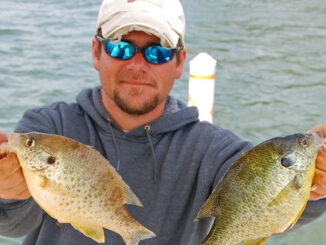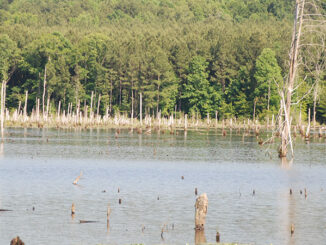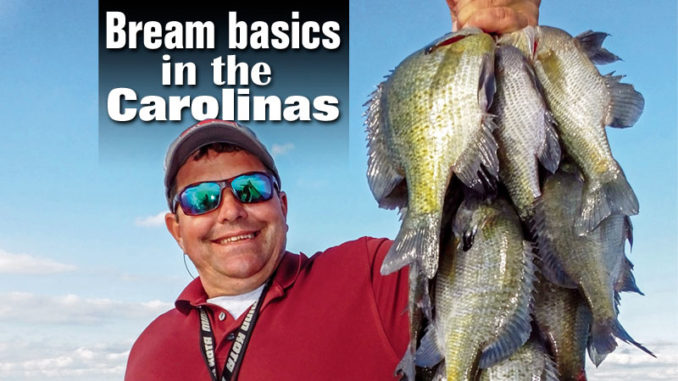
June is prime time to catch bedding bream across the Carolinas, but you have to find them first. Here’s how to learn where to look….
Bream fishing is one of the most highly anticipated events of the spring fishing season, and with just cause. By late May and June, bream have flooded into the shallows and will aggressively attack crickets, worms and artificial lures in their vicinity. If you find a bed of spawning bream, the action can be simply sensational, and limits of the biggest bream of the year can be taken in short order.
But even a species as prolific and abundant as bream has patterns that makes catching them easier.
Kevin Davis guides on South Carolina’s Santee Cooper lakes and has fished for bream throughout the Carolinas and the southeast, and he’s developed shallow-water tactics that work for him everywhere.
“The key is to understand that not all bream habitat is created equal,” said Davis, who runs Black’s Camp on the Diversion Canal between Lake Marion and Lake Moultrie. “It’s easy to think fishing around cover such as brush, weeds, trees or docks seals the deal. But the fact is, the bottom substrate is a major location key for bream. They prefer sand or gravel bottoms for bedding, not mucky bottoms, so targeting the right bottom substrate is a key. They’ll fan out small circular individual beds and they may have a few beds, or hundreds, in a specific area. Find this and you’re in the bream-catching business.”
Davis (843-753-2231) said by wearing polarized sunglasses and scanning shallow water, he’ll spot the beds visually if the water is clear. If the water is dingy, he’ll use light spinning tackle or 12-foot long fiberglass poles to fish around woody and weedy cover growing on the right kind of bottom.
“I enjoy fishing the shallow water for bream at this time of the year, because the action is consistently good, whether I’m on a bed or not,” he said. “Catching a bull bream or two at the same spot is an indicator to stop moving and fish the entire area thoroughly. But when I catch a small ‘hen’ bream, I’ll keep moving until I find larger fish.”
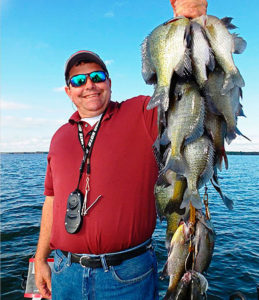
Davis said bream don’t all bed at the same time, and his timing preference for peak bedding action is three days before and after a full moon. While June is prime time for bream bedding, he said not all bream bed at the same time, nor do they bed continuously.
“The traditional peak bedding times are in sync with moon phases, but bream may bed any time the water is warm enough,” he said. “Even when they’re not bedding, June is a killer time to catch limits of huge bream. I fish the same technique as I do when searching for a bream bed — fishing shallow cover and moving until I hit catch some big bream. When the action slows, I move and hunt the next spot.”
He said bream still congregate in big numbers, but not like when they’re bedding. He may catch a couple or several any a given spot instead of dozens, but by moving and finding multiple areas, the number adds up quickly.
Davis said the best baits for June bream fishing are live crickets and red worms, but small spinners on light tackle and popping bugs used with fly,rods are productive.
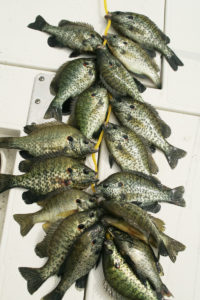
“Crickets seem to produce better action on bluegill, and red worms are best for shellcrackers, but both works for either species,” he said. “I’ll typically have worms and crickets with me, and if I catch a shellcracker on a cricket, I’ll search the area with worms before moving.”
Bream fishing in the Carolina’s is serious business for bream-fishing addicts, who are always on the lookout for new and improved methods to catch them.
T.C. Lloyd of Hartsville, S.C., guides for a number of species, often relying on modern electronics to help him put his parties on fish. He said he has elevated his bream-fishing with those same electronics.
“I’ve always loved catching big bream on the beds, but now with the side-imaging electronic resource available, I’ve learned how to look for beds and actually see bream marked on those beds, before I set up to fish,” he said.
Lloyd uses the side-scan capability on his graph to mark bream beds. And he doesn’t look for beds just in shallow water near the shoreline. With side-scan, he can find beds far from the bank.
Lloyd (843-307-6678) said that he used to search for bream beds by fishing good bottom substrate and cover it with traditional bream fishing gear. While learning the intricacies of the side-scan process, he slowly motored around the shoreline scanning both sides of the boat. He began finding beds far away from the bank, often on the opposite side of the boat from the shoreline.
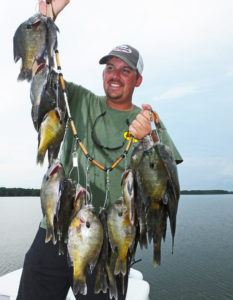
“This morphed into my current process; now, I now search far from the shoreline in places where the bottom substrate and depth are right,” he said. “If the bottom conditions and depth are right, huge bream beds can be found far from the shoreline.”
Lloyd said once he locates a bed, he’ll anchor a short distance away so he doesn’t spook the fish. He’ll cast to his target using light spinning tackle, and when the action slows, he repeats the process.
Catching big bream during June is a tradition in the Carolinas. This year have a game plan enabling you to spend more time fighting big bream than searching for them.
Side-scan for bream beds
Guide T.C. Lloyd of Hartsville, S.C., said plenty of fishermen employ side-scan sonar when targeting fish like bass, crappie and catfish, so why not use it for finding bream beds?
“I’ve always enjoyed the traditional methods of finding bream beds, but using the side-scan sonar allows me and my clients or family and friends to spend much more time hooking and fighting big, bull bream,” he said. “While not everyone has side-scan imaging graphs, they’re becoming much more prevalent on sonar units.”
“I’ll set my side-scan search to 80 to 100 feet on either side of the boat,” he said. “I want to see the beds clearly; they’ll show up as clusters of dimples in a honeycomb pattern on the screen. Some bedding areas will have hundreds of individual beds, while others may have a dozen or two.”

“The individual beds show up slightly darker in the fanned depression where they’re slightly deeper, and hot marks in the center of the beds are fish actively on the beds,” he said. “I save these spots as waypoints, then return later and find bream actively bedding in July and August.
“Many of these same bedding areas will be productive because the bottom substrate on the lake in that specific area is ideal for beds. I have found June is consistently the peak month for the most beds and usually the largest bream.”
Lloyd said that, far from the shoreline on open-water flats, bream often bed in areas with no additional wood or weed cover.
“If the bottom composition and depth are right, they don’t need additional cover,” he said. “I’ve found huge beds over a half-mile from the shoreline. And the exact location of a big bed may change from one year to the next, that same general area will likely have bedding bream next year.”

